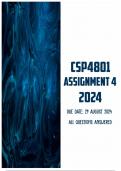, PLEASE USE THIS DOCUMENT AS A GUIDE TO ANSWER YOUR ASSIGNMENT
Please note that the author of this document will not responsibility for any plagiarizing you
commit.
Lerato is a newly qualified Mathematics and English First Additional Language teacher at an under
resourced primary school.
Interested to understand the concept of emotional intelligence, Lerato decided to explore her Grade 6
learners’ emotions by asking them to complete tasks in Mathematics and English First Additional
Language. She observed her learners while doing their tasks and took some notes. The data she
gathered showed that some learners experienced positive emotions while others experienced negative
emotions during the task completion. The negative emotions included frustration, boredom,
annoyance, anger, lack of interest in doing the task and some anxiety. The positive emotions included
pride and happiness.
1. Emotional intelligence is described as a skill that helps people understand and manage their
emotions and behaviours. It is therefore deemed important that teachers help their learners
understand and control their emotions because “learning is likely to be more effective if
educators help to minimise stress and fear at school, teach students emotional regulation
strategies, and provide a positive learning environment that is motivating to students” (Hinton,
Miyamoto & Della-Chiesa, 2008). Using motivation and behavioural theories (and any relevant
model), design intervention strategies or guidelines to help Lerato address the negative emotions
the learners experienced.
Introduction
Emotional intelligence (EI) has emerged as a critical factor in education, influencing both students'
academic performance and their overall well-being. According to Hinton, Miyamoto, and
Della-Chiesa (2008), educators who prioritize emotional regulation and create a positive learning
environment contribute to more effective learning. For Lerato, a newly qualified Mathematics and
English First Additional Language teacher, understanding and managing her learners' emotions is
essential, especially in an under-resourced primary school where challenges abound. After observing
that her Grade 6 students experienced a mix of negative emotions, such as frustration, boredom,
anger, and anxiety, as well as positive emotions like pride and happiness during task completion,
Lerato seeks intervention strategies to address these issues. This essay will propose strategies based
on motivation and behavioral theories that can help Lerato create a supportive environment for her
students, minimizing negative emotions and fostering a positive learning experience.
Understanding Emotional Intelligence in Education
Emotional intelligence, the ability to perceive, understand, and manage emotions, plays a crucial role
in education. Teachers with high EI can better recognize their students' emotional needs and create
environments that support emotional well-being. Emotional intelligence in the classroom involves
teaching students how to identify and regulate their emotions, which can reduce stress, enhance
motivation, and improve academic outcomes. For Lerato, developing her students' emotional
intelligence is key to helping them navigate the challenges they face during task completion. When
students are taught to manage emotions like frustration, anger, and anxiety, they are more likely to
stay engaged and motivated, leading to better academic performance. Therefore, incorporating
emotional intelligence into teaching practices is not only beneficial but essential, particularly in
environments where students may already be facing external stressors, such as those present in
under-resourced schools.





